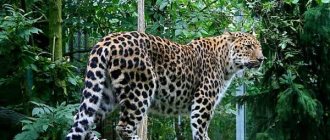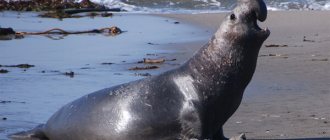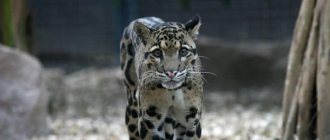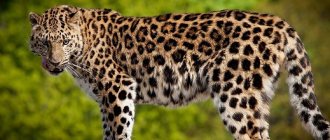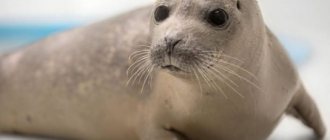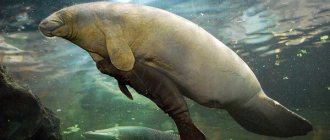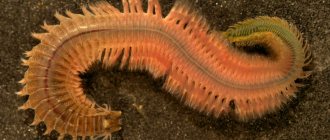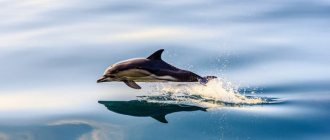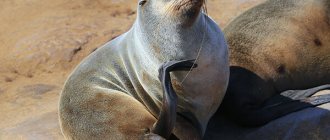- Wild animals
- >>
- Mammals
The leopard seal is an amazing creature that lives in Antarctic waters. Although these seals play a unique role in the Antarctic ecosystem, they are often misunderstood as a species. There are many interesting aspects to know about the life of this formidable Southern Ocean predator. This type of seal is almost at the very top of the food chain. It got its name because of its characteristic color.
Origin of the species and description
Photo: Leopard seal
It has long been assumed that marine mammals of the pinniped group descended from a common land-dwelling ancestor, but no clear evidence of this has yet been found. The discovery of fossils of the species Puijila darwini, which lived in the Arctic during the Miocene (23-5 million years ago), provided this missing link. A well-preserved skeleton was found on Devon Island in Canada.
From head to tail, it measured 110 cm and had webbed feet instead of the fins that its modern descendants sport. Webbed feet would allow it to spend part of its time hunting for food in freshwater lakes, making travel on land less awkward than flippers in winter, when frozen lakes would force it to search for food on solid ground. Its long tail and short legs gave it a river otter-like appearance.
Video: Leopard seal
Although land animals are thought to have originally evolved from marine life, some—such as the ancestors of whales, manatees, and walruses—eventually crawled back into aquatic habitats, making these transitional species like Puijila an important chain in the evolutionary process.
French zoologist Henri Marie Ducrotay de Blainville was the first to describe the leopard seal (Hydrurga leptonyx) in 1820. It is the only species in the genus Hydrurga. Its closest relatives are the Ross, crabeater and Weddell seals, known as Lobodontini seals. The name Hydrurga means "water worker" and leptonyx is Greek for "little claw".
Appearance and features
Photo: Animal leopard seal
Compared to other seals, the leopard seal has a distinctly elongated and muscular body shape. This species is known for its massive head and reptile-like jaws, which allow it to be one of the top predators in its environment. A key feature that is hard to miss is the protective coat, with the dorsal side of the coat being darker than the ventral side.
Leopard seals have a mixed silver to dark gray coat that makes up the characteristic "leopard" coat with a spotted pattern, while the ventral (underside) side of the coat is a lighter white to light gray color. Females are slightly larger than males. The total length is 2.4–3.5 m, and the weight is from 200 to 600 kg. They are about the same length as the northern walrus, but leopard seals weigh almost half as much.
The ends of the leopard seal's mouth are constantly curved upward, creating the illusion of a smile or a menacing grin. These involuntary facial expressions add a frightening appearance to the animal and cannot be trusted. They are potentially aggressive predators that constantly monitor their prey. On rare occasions, when they come onto land, they protect their personal space by emitting a warning growl at anyone who is too close.
The streamlined body of the leopard seal allows it to gain great speed in the water, striking synchronously with its highly elongated forelimbs. Another notable characteristic is the short, clear whiskers, which are used to explore the environment. Leopard seals have a huge mouth in relation to their body size.
The front teeth are sharp, like those of other carnivores, but the molars connect to each other in such a way as to sift krill from the water, much like a crabeater seal. They do not have external pinnae or ears, but they do have an internal ear canal that leads to an external opening. Hearing in the air is similar to that of humans, and the leopard seal uses its ears along with its whiskers to track prey underwater.
Where does the leopard seal live?
Photo: Leopard seal Antarctica
These are pagophilic seals, whose life cycle is completely connected with the ice cover. The main habitat is the Antarctic seas along the perimeter of the ice. Adolescent individuals are observed on the shores of the subantarctic islands. Stray leopard seals have also been recorded on the coasts of Australia, New Zealand, South America and South Africa. In August 2022, one individual was spotted in Geraldton on the west coast of Australia. In West Antarctica, leopard seal densities are higher than in other regions.
Fun Fact: Lonely male leopard seals hunt other marine mammals and penguins in the ice-bound Antarctic waters. And when they are not busy searching for food, they can drift on ice floes to rest. Their external coloring and unmistakable smile make them easily recognizable!
Most members of the genus remain inside the pack ice throughout the year, being completely isolated for most of their lives, with the exception of the period when they are with their mother. These matrilineal groups may move further north during the Australian winter to the subantarctic islands and coastlines of the southern continents to ensure proper care of the young. While single individuals may appear in areas of lower latitudes, females rarely breed there. Some researchers believe that this is due to problems with the safety of the offspring.
Interesting Facts
- Scientists suggest that cases of predator attacks on humans are not associated with unfriendliness and an aggressive disposition. The fact is that a predator waiting for prey under water cannot always see the prey.
- With the onset of winter, these mammals leave the northern waters and go to the coast of Australia. Signs of the presence of leopard seals have even been found off the coast of Easter Island.
- Most underwater leopards feed on penguins when more suitable food is not available. However, there are also gourmet individuals who prefer to eat mainly the meat of unfortunate penguins.
What does a leopard seal eat?
Photo: Leopard seal
The leopard seal is the dominant predator of the polar region. Developing speeds of up to 40 km/h and burying itself to a depth of about 300 m, it leaves its prey little chance of escape. Leopard seals have a very varied diet. Antarctic krill makes up about 45% of the total diet. Menu may vary depending on location and availability of tastier harvested foods. Unlike other members of the family, the diet of leopard seals also includes Antarctic marine mammals.
The most common victims of the leopard seal's insatiable appetite are:
- crabeater seal;
- Antarctic fur seal;
- eared seal;
- penguins;
- Weddell seal;
- fish;
- birds;
- cephalopods.
The resemblance to the cat's namesake is more than just skin coloring. Leopard seals are the most fearsome hunters of all seals and the only ones that feed on warm-blooded prey. They use their powerful jaws and long teeth to kill prey. They are efficient predators that often wait underwater near ice shelves and catch birds. They can also rise from the depths and grab birds on the surface of the water in their jaws. Shellfish are a less dramatic catch, but an important part of the diet.
Fun fact: Leopard seals are the only seals known to regularly hunt warm-blooded prey.
A curious incident occurred with photographer Paul Nicklen, who, despite the danger, was the first to dive into Antarctic waters to capture leopard seals in their natural environment. Instead of an evil sea demon, he encountered a cute female leopard, who probably thought that this was a stupid baby seal.
For several days, she brought live and dead penguins as food for Nicklen and tried to feed him, or at least teach him how to hunt and feed himself. To her dismay, Nicklen wasn't too interested in what she had to offer. But he got phenomenal photos of an intriguing predator.
Attacks on people
Sometimes leopard seals also attack people. On July 22, 2003, British scientist Kirsty Brown became the victim of a similar attack while diving. For six minutes, the leopard seal held her with its teeth at a depth of 70 m until she suffocated. This is the only fatal attack on a human associated with leopard seals so far, although there have been repeated attacks in the past. Leopard seals are not afraid to attack boats and jump out of the water to grab a person by the leg. The targets of such attacks are usually employees of research stations. The reason for this behavior of leopards is their tendency to attack animals located on the edge of ice floes from the water. At the same time, it is not easy for a leopard seal from the water to recognize or distinguish who exactly its prey is.
Features of character and lifestyle
Photo: Leopard seal
Research shows that the average aerobic dive limit for young seals is about 7 minutes. This means that during the winter months, leopard seals do not eat krill, which is a major part of the diet of older seals, as krill are found deeper. This can sometimes lead to hunting together.
Interesting fact: There have been recorded cases of cooperative hunting of Antarctic fur seals, carried out by a young seal and possibly its mother helping her grown pup, or perhaps the interaction of a female + male pair to increase the productivity of the hunt.
When a leopard seal gets tired of eating but still wants to have fun, it can play cat and mouse with penguins or other seals. As the penguin swims to shore, a leopard seal cuts off its escape route. He does this again and again until the penguin either manages to make it to shore or succumbs to exhaustion. There doesn't seem to be any point to this game, especially since the seal expends a huge amount of energy in this game and may not even eat the animals they kill. Scientists have speculated that it is clearly for sport, or perhaps it could be young, immature seals looking to hone their hunting skills.
Leopard seals communicate very poorly with each other. They typically hunt alone and never encounter more than one or two other individuals of their species at the same time. The exception to this solitary behavior is the annual breeding season from November to March, when several individuals will band together. However, due to their exceptionally unpleasant behavior and solitary nature, little is known about their complete reproductive cycle. Scientists are still trying to figure out how leopard seals choose their mates and how they delineate their territories.
These are solitary animals
The exceptions are females with cubs and pairs during the breeding season. Leopard seals copulate in the summer, with a gestation period of about 11 months, at the end of which one cub is born. Feeding the offspring with mother's milk lasts about a month. Females become sexually mature between three and seven years of age. Males mature slightly later, usually between six and seven years of age. The average life expectancy is 12 to 15 years.
Social structure and reproduction
Photo: Leopard seal animal
Because leopard seals live in places inaccessible to humans, little is known about their breeding habits. However, their breeding system is known to be polygynous, meaning males mate with multiple females during the mating season. A sexually active female (aged 3–7 years) can give birth to one young during the summer by coming into contact with a sexually active male (aged 6–7 years).
Mating occurs from December to January, shortly after the weaning of the grown-up calf, when the female is in estrus. In preparation for the birth of their seal pups, females dig a round hole in the ice. The newborn cub weighs about 30 kg and is with its mother for a month before it is weaned and taught to hunt. The male seal does not participate in caring for the babies and returns to his solitary lifestyle after the mating season. Most leopard seal breeding occurs on pack ice.
Interesting fact: Mating takes place in the water, and then the male leaves the female to care for the calf, which she gives birth to after 274 days of pregnancy.
It is believed that sound is very important during breeding, since at this time males are much more active. These vocalizations have been recorded and are being studied. Although little is known about why these sounds are made by males, they are thought to be related to aspects of their breeding and reproductive behavior. Hanging upside down and swaying from side to side, adult males have characteristic, stylized postures that they reproduce with unique consistency and which are believed to be part of their breeding behavior.
From 1985 to 1999, five research cruises were made to Antarctica to study leopard seals. Observations were made of seal pups from early November to late December. The scientists observed that there was about one pup for every three adults, and also saw that most females stayed away from other adult seals during this season, and when seen in groups, they showed no signs of interaction. The mortality rate of leopard cubs during the first year is close to 25%.
Lifestyle
During the daytime, the sea predator lies peacefully on the ice floe, and with the onset of night, when clouds of krill rise to the surface from the depths, it is lunch time for the leopard seal.
- 34 facts about raccoons
- Maned wolf
- Nettle
- Elk
- 100 facts about bears
- Jungle animals
Krill make up approximately 45% of a leopard's diet, with a further 10% coming from various fish and cephalopods. The special structure of the jaws allows water to pass through the teeth and retain krill and fish in the mouth. However, it was not the consumption of krill and fish that brought leopard seals the fame of predators, but the hunting of large animals. In autumn, leopard seals become more aggressive and more often approach the shore, where they find fat fur seals and young, inexperienced penguins in the water. Leopard kills animals for fat. Arctic explorers often witnessed leopard attacks on penguins.
Penguins are very agile and maneuverable in the water and have many advantages over huge leopard seals. Therefore, hunting for an experienced adult penguin will not bring success; fat and well-fed chicks become the object of the predator's hunt. A leopard watches for prey in shallow water or hides behind an iceberg. If penguins sense an enemy, they are in no hurry to jump into the water. In this case, the leopard rolls ashore on its own, but on land it is very clumsy and clumsy. He is agile and maneuverable only in water.
Birds, retreating a couple of steps from the water, become inaccessible to him. But in the water, a bird caught in the teeth of a predator is doomed. Sometimes a leopard seal can play with a wounded penguin, throw it into the air, and drown it. After that, he tears the bird apart and removes the skin and feathers. The predator clamps its teeth on the body and shakes its head in different directions until the skin comes off and it gets to the desired fat. The seal does not eat meat, it goes to starfish. The hunt does not end there; the predator chooses its next victim.
The life of the leopard seal has been little studied; data about them comes from research expeditions. In spring and summer, males are near icebergs, dive into their voids and sing their mating songs there, amplifying the sound and thus attracting females for mating.
Pregnancy lasts eleven months, and babies appear in the last months of spring or early summer. The weight of the cub reaches 30 kilograms, length – 1.5 meters. The birth takes place on an ice floe; the female feeds the cub with milk for one month, then teaches it to swim and teach it to hunt. If adult individuals prefer solitude, then young leopard seals unite in packs. They reach sexual maturity at four years of age.
The number of leopard seals is 400 thousand. And although, according to experts, they are not in danger of extinction, these Arctic animals are very vulnerable. Their whole life is connected with drifting ice floes and icebergs, they rest on them, and their young are born on the ice floes. Global warming entails changes in the way of life of these animals, formed over millions of years. Today no one can say how these changes will affect the sea giants.
Natural enemies of leopard seals
Photo: Leopard seal in Antarctica
It's not easy to live a long, healthy life in Antarctica, and leopard seals are lucky to have not only an excellent diet, but also virtually no predators. Killer whales are the only identified predator of these seals. If these seals manage to escape the killer whale's wrath, they could live up to 26 years. Although leopard seals are not the largest mammals in the world, they can live for an impressively long time given their stressful and rugged habitat. In addition to killer whales, large sharks and, possibly, elephant seals may try to hunt small specimens of leopard seals. The animal's fangs are 2.5 cm.
Trying to study these creatures can be dangerous, and in one case a leopard seal is known to have killed a person. Not long ago, a marine biologist working for the British Antarctic Survey drowned after being dragged nearly 61m below sea level by a seal. It is currently unclear whether the leopard seal intended to kill the biologist, but most importantly, it is a sobering reminder of the true nature of these wild animals.
When hunting penguins, the leopard seal patrols the waters near the edge of the ice, almost completely submerged, waiting for the birds to head towards the ocean. He kills swimming penguins by grabbing their legs, then vigorously swinging the bird and repeatedly slamming its body against the surface of the water until the penguin dies. Previous reports that the leopard seal cleans its prey before feeding have been found to be incorrect.
Lacking the teeth necessary to cut its prey into pieces, it swings its prey from side to side, tearing it into smaller pieces. At the same time, krill are eaten by suction through the seal's teeth, allowing leopard seals to switch to different feeding styles. This unique adaptation may indicate the seal's success in the Antarctic ecosystem.
They can play with their food
Leopard seals are known to play cat and mouse with their prey, usually young seals or penguins. They will chase their prey until it runs away or dies, but will not necessarily eat the prey. Scientists are not sure of the reason for this behavior, but believe that it helps hone their hunting skills or is a form of entertainment.
